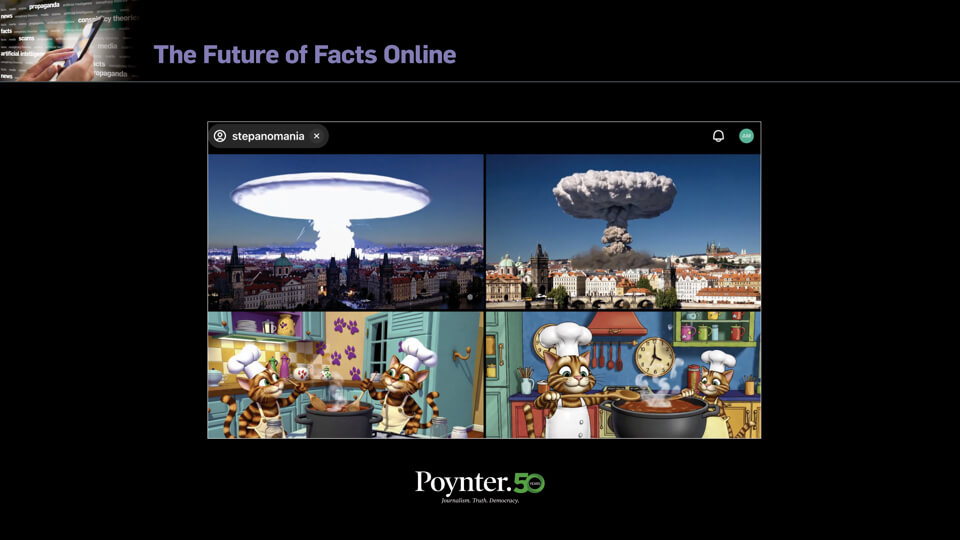Layoffs. Buyouts. Staff reductions. Economic headwinds. Re-organizations. News fatigue. Mistrust. Distrust. No trust.
These are some of the words and phrases that many people use nowadays to describe the state of journalism and the news business.
But is it really that bad? Is it all just a bunch of doom with a heavy dose of gloom?
Actually, no.
While it’s a stretch to say these days are sunshine and rainbows for journalism, it certainly isn’t all storms and dark clouds.
That is a major theme in a new, first-of-its-kind report from The Poynter Institute examining current trends in the news and media industry.
The project — “OnPoynt — Values Rising: Trends and traction in journalism and the news industry” — publishes today and was produced by Poynter in conjunction with Magnet Media.
In the opening of the report, Poynter president Neil Brown writes that “doom and gloom narratives that cherry pick stories of vulture capitalists, job loss statistics and print closures are incomplete or out of date, painting an inaccurate picture of a news and information ecosystem on life support. OnPoynt aims to offer a forward-minded look at the state of journalism and the news industry that propels the story by considering trends related to creative product ideas, audience growth strategies and traction around revenue, artificial intelligence and innovation.”

Poynter president Neil Brown
This detailed report acknowledges the challenges that news outlets face, but it also celebrates examples of hope and creativity thanks to new, different and inspired work from news organizations big and small. It also asks journalists to widen their perspectives on how to serve audiences beyond offering up traditional content.
As Brown explains, “As the industry navigates these complications, it is imperative for news organizations to adapt, innovate and redefine their value. By embracing new formats, fostering community engagement and delivering compelling storytelling that resonates with diverse and distinct audiences, journalism reinvigorates its connection with the people it serves.” One of the takeaways is a call to action for news executives to “Lead more, lament less.”
Ahead of today’s release, I sat down with Brown, one of the authors of the report. We talked about why Poynter is publishing it, the state of the news industry and why the report suggests it’s OK—– for the journalism field to engage in a bit of optimism.
Tom Jones: Tell me about this project. Why did you do it, and why now?
Neil Brown: We’ve been talking about doing this for two basic reasons. First, the general coverage of the news industry paints a drumbeat of negative news. And I get that. The journalism industry has always bent over backwards as a sort of sign of its credibility to talk about its challenges, warts and all. That’s what we do with other institutions, politicians, people we cover, We try to point out the problems and suggest answers. So when it comes to our own issues, I think it’s a well-intended and, frankly, honorable approach to being transparent about what’s going on. No doubt about it – we are in an industry where news organizations are getting smaller and the relationships with our customers have changed in difficult to navigate ways. There’s been a climate of layoffs, revenue and audience challenges. All of that is true. But here’s the thing: It’s been true now for going on 15 years. I get that. I’ve been a part of it.
But at the same time, I think we haven’t freshened the story to note that while things are changing and going away, there are new things stepping up in their place. Maybe not the exact same things, but that’s evolution, really. We have new organizations coming in and doing or trying new approaches, new experiences, either to serve audiences that have been abandoned by traditional news organizations, or attracting brand new audiences who weren’t into journalism. And they’re doing it with new and interesting forms. I believe the news industry, of which Poynter has a particularly unique advantage to see, has been doing more of that, and yet that’s not getting as much notice.
TJ: But you’re not saying it’s a one-for-one, right? That everything bad that has happened is being replaced by something good.
NB: What I am saying is the story of journalism and the news industry in decline is, one, partly tired and, two, incomplete and not current because other things are coming forward. And despite this sort of narrative that there’s news fatigue, there’s profound news interest. Some of this goes to how do you define what news is? People are interested in a lot of stuff. That doesn’t mean they love it all. It doesn’t mean they’re not polarized. It doesn’t mean it’s happy. It doesn’t mean it’s not depressing a lot of the time. But it doesn’t mean audiences have tuned it out. There’s a little bit of a default to thinking that it’s so depressing or polarizing that people don’t want to hear it. Sure if all you judge is a national debate or intense troubles abroad. Even then, people are interested. But there is much more going on than just that. And people of all circumstances are interested in a variety of stuff, other types of stories, local information. And you know who’s got a particular perspective on that? Poynter.
TJ: Can you give me some examples of the good things in the industry that you’re now seeing?
NB: So the report references The Baltimore Banner, which just hit their second anniversary. This is a nonprofit startup, a digital organization in Baltimore, that is funded by a family foundation that decided that Baltimore was not being fully served journalistically. So it took a chance with upfront funding and fundraising and it’s now taken root, and it announced the other day that it was starting a five-person education coverage team at a time when other news organizations may, in fact, be cutting back on their education coverage. Their newsroom headcount is about 80. Well, that’s bigger than pretty much every local news organization here in Florida and in most states, and they’re only 2 years old. And there’s still the Baltimore Sun, which probably has a comparable staff plus TV news and more. So Baltimore seems to be increasingly well served. That’s an interesting advance. Does it negate the cuts and difficulties in other markets, including recently Tampa Bay? No.
TJ: What else?
NB: I just finished my last year as the Pulitzer Board Chair. And we gave in the past two years Pulitzer Prizes for local news coverage to two very small digital news startups, One was Lookout Santa Cruz, which won for breaking news in covering catastrophic flooding and mudslides. The Lookout provided so much service journalism in ways that years and years ago, the main or larger news organization in town might have provided, or perhaps the leading TV station does provide. It was such effective service journalism with a very small staff that you could see how they are connected to their community as a journalistic enterprise providing value. Well we don’t talk about that as much. Or how about the growth and journalistic success at AL.com. It is a statewide journalism enterprise that has embraced the traditions of papers like the Birmingham News but moved to a digital initiative that is among the largest local news operations in the country. It is doing Pulitzer Prize-winning work through traditional and new products. There’s a lot of good print stuff in the journalism field still out there, too, from community weeklies to magazines. But these things aren’t getting as much attention. Too much of the coverage is about the losses and pining for when can we go back to the old days? We all know we’re not going back to the old days.
Please understand, I’m not saying everything’s perfect and that there’s nothing but great stuff ahead, but I am saying I’m not hearing enough of the good stuff. The story is incomplete when you talk about the news industry.
TJ: And how does Poynter fit into this?
NB: Poynter is working with public media organizations around the country to help them adapt. We recently finished a program in 75 public media markets and are about to start a new collaboration with the Corporation for Public Broadcasting to work in 225 markets around the country, helping public media, often NPR affiliates or PBS affiliates, TV as well, to improve their digital journalism offering, recognizing it can’t all be about drive time anymore. People aren’t listening to audio journalism that way. So we’re working with these stations as they expand their digital journalistic offerings. We’re helping them share best practices as they do events, as they become more rooted in their community. And we’re picking up a lot of knowledge from these guys who are on the ground, doing local news and seeing local news maybe in a different frame than it had been in the past, And through this report, we’re trying to share some of what we’re seeing out there.
TJ: Still, Neil, there are a lot of places out there that are still struggling. Layoffs, cuts and so forth. Just recently, the paper that Poynter owns and where you used to be the editor, the Tampa Bay Times, cut staff by 20%, or about 60 people, through buyouts.
NB: Yes, that’s absolutely a fair point. Look, the report, even as it’s attempting to be counterintuitive, is not trying to paint some rosy, pollyanna picture. It’s very difficult out there for a lot of local news organizations, including the Tampa Bay Times. But what the report is suggesting is that maybe we share some of the best practices, some of the values, some of the techniques, some of the struggles, yes, but also some of the successes that, let’s say, content creators, are having. Or that some of the small nonprofits are having. Some have come up with new ways to serve communities. Maybe it’s through the use of technology. For example, more and more organizations are turning to their newsletters as a way to reach their audiences, not just with their main products. Some are even starting to charge for newsletters. We’ve been waiting to see what some new economic models look like.
In the case of content creators, they have used TikTok, other vertical video like Instagram, social media, to have connections with their audience on a personal basis — some of which is a form of journalism, some of which is not journalism at all. But what we’re seeing is that those having success are those that can somehow form relationships with their audiences. They have managed to do better than just having a general one-size-fits-all approach. And so I think even for those that are still struggling, and there’s plenty that are still struggling, figuring out how to pivot to some new things, how to build a culture of experimentation, should be a little bit of what this report inspires.
TJ: Where does the support come from?
NB: One of the components that this report discusses is the growing movement of philanthropic support for local news. It’s exciting the way foundations and other donors and philanthropists, membership campaigns are increasingly supporting local news. But we come at that also with this cautionary note: It’s not a panacea. The report wants to stress that when it comes to your products, the marketplace will still decide, not the donors. So they’re going to fund and prop up some local news to get some things started. Some of the success stories are absolutely funded through philanthropy. But whether it’s going to last is going to depend on whether you’re ultimately providing value to your customers, not just whether you can get another grant to fund it. One of the challenges that we’ve seen is that news organizations really have to thread that needle between your journalistic thinking and understanding what it is the audiences want? And it doesn’t matter whether you get a billionaire or a foundation or an advertiser to fund it, the marketplace will vote. People just don’t have time for stuff that they’re not interested in. They just don’t have time for or won’t pay for stuff that isn’t useful enough to them. And interest doesn’t have to mean happy or light. It can mean value. It can help you make your vote during an election. It can help you figure out the next COVID question. It can help you with your kids’ school. But news organizations, no matter who’s funding it, they’ve got to provide value and make sure that they’ve got some kind of way to make sure the audience knows about it.
So then we hear news organizations saying, well, there’s some strong headwinds out there, as we’ve been saying now for a decade, right? I get it. I’m not denying that. I’m not disrespecting that. But the truth is, if the headwinds are so strong, we might want to change course and do something different. I think that also includes investing in technology and not just paying lip service to providing a better user experience.
TJ: Tell me more about that — the user experience.
NB: In general, one thing that you hear a lot about overall is people don’t like the user experience from their news sources. We’ve migrated so much of the audience to digital journalism, and with the exception of a lot of big national corporations that have the wherewithal, the user experience and the technology are a source of frustration. And the point I’m making is it’s not necessarily content. It’s not necessarily that they don’t like the journalism or that it’s news fatigue. It’s just too much of a pain in the neck to get the stuff, see or read the content. Audiences get frustrated. So we have to kind of be more holistic in thinking about how we serve people – going beyond the content only.
TJ: What is something that you personally learned in putting together this report?
NB: It became more clear to me that new products, new newsletters, and some of the techniques that content creators are trying could factor into reaching audiences and freshening the news and info marketplace. Rather than be scared or say things like ‘That’s not journalism,’ I kind of came away thinking that a wider understanding of new tools and storytelling techniques at your disposal could help you reach new audiences, instead of thinking, “That’s them, and this is us.”
TJ: We saw there was some complaining from many journalists about content creators at the recent Democratic National Convention.
NB: I would call it some minor chafing by traditional journalists. Like, “What are they doing here?” All I know is, even those where they make their partisan biases clear had some pretty interesting reports and got some pretty interesting stuff. Individuals — influencers, creators — are reaching audiences in ways that audiences find very, very compelling, but they don’t have an institution behind them. Meanwhile, institutions are struggling because they don’t have the personalities. So the question is, can one group borrow from the other? I ask, is there something the institutions can learn from them, like how to tell stories differently? Take Dave Jorgenson of The Washington Post who is on TikTok. Or Jamelle Bouie of The New York Times on TikTok. They’re reaching a whole new set of audiences that are not going to subscribe to The New York Times but they’ll read his column or listen to his column on TikTok, or that style of storytelling. And those, of course, are very traditional examples.
TJ: I see reports all the time about where the news industry is, and where it’s going. What makes this different?
NB: I did say from the get-go: I’m not interested in one more scolding report that says things like, “People don’t care about facts. People don’t like journalism.” I believe there is some interesting stuff going on. So our goal here is to say let’s widen the perspective. Let’s tell a more complete story.
More resources for journalists
- Lead With Influence is for leaders who manage big responsibilities but have no direct reports.
- Public media journalists: It’s the last week to apply for our Digital Transformation Program.
- Find compelling climate change stories on any beat at Beat Academy.
Have feedback or a tip? Email Poynter senior media writer Tom Jones at tjones@poynter.org.
The Poynter Report is our daily media newsletter. To have it delivered to your inbox Monday-Friday, sign up here.







